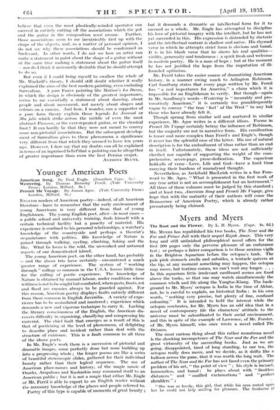Pure Form -
As long as there are still people whci find the more advaneed 'kinds of modern' painting difficult to grasp, it will always be 'valuable to offer them new methods of approach and. new Wray arguments which ay clear away the prejudices which come between them and the paintings they see. This is what Mr. -Wackrill has apparently set out to *do. Since he is dealing with the rather well-worked field of Post-Impressionism. Fauvism and Cubism it is not to be expected that his theories should be in their fundamentals 'very novel,- and the reader is in fact constantly reminded of the writings of Roger Fry and his followers. But this does not affect the merit of the btiok, which can certainly claim to be the best general exposition of certain ideas underlying modern painting. If it has not that incomparable penetration which makes Roger Fry's essays S4/ constantly startling, it has the advantage of being more sys- tematic than they, and its clarity and simplicity of style put it altogether above the more journalistic expositions of Fry's followers. Moreover, whatever ideas Mr. Wackrill has bor- rowed have been fully absorbed into his general scheme, and the book as a whole impresses the reader as a work of individual thought embodying conclusions which the author has tested for himself.
If, therefore, I venture to criticize Mr. Wackrill it is not . because I doubt the value of his book as an introduction to modern painting, but because I do not feel confident that his theory is absolutely water-tight, or that it entirely fits the facts of modern painting. Mr. Wackrill states the theory of Pure Form in its extreme development : in all art representa- tion counts for nothing and design for everything. The Fauves "looked upon the images in their designs simply as interrelated organizations of form and colour capable of transmitting aesthetic feeling, without reference to them as present- ments which might contain other non-plastic emotional allusions." Celzanne believed that " form, to attain its greatest significance, must be winnowed of all reference to ideas associated with it." Painting, therefore, is a matter of pattern and colour ; it is exactly on a level with a carpet. Undoubtedly paintings have been produced (by Herbin and his circle) in which there is no representation at all—though it does not follow that the forms have no associations. But in any case these purely abstract works are rare, and I believe Mr. Wackrill would agree with me that they include no great works of art (in his book he reproduces no painting approaching pure abstraction). The important case is that of works involving a considerable degree of distortion, in which the artist has moved far from nature, but has left clues by which the objects in his composition are recognizable-- say, the Braque opposite p. 8. Here I find it impossible to believe that even the most plastically-minded spectator can succeed in entirely cutting off the associations which the pot and the guitar in the composition must arouse. Further, those associations seem to me inextricably tied up with the shape of the objects, and, as a matter of personal opinion, I do not see why these associations should be condemned as irrelevant. In other words, I do not see how an artist can make a statement in paint about the shape of a guitar without at the same time making a statement about the guitar itself —nor do I think it necessarily desirable that he should attempt to do so.
But even if I could bring myself to swallow the whole of Mr. Wackrill's theory, I should still doubt whether it really explained the aims of the best modern painting, even excluding Surrealism. A pure Fauve painting like Matisse's La Danse, in which the design is obviously of the greatest importance, seems to me essentially a statement about dancing, about people and about movement, not merely about shapes and colours on a canvas. And how, I wonder, can a supporter of a pure form theory explain those legends Le Journal or Ma jolie which strike across the middle of even the most abstract Picassos, or the ever-repeated guitar, or the classical bust ? It can hardly be that they were not meant to convey some non-pictorial associations. But the subsequent develop- ment of Surrealism gives to these phenomena a significance very different from that which they seemed to have ten years ago. However, I dare say that my doubts can all be explained
in terms of an ingrained belief a painting can be altogether of greater importance than even the best Persian carpet.
ANTHONY BLUNT.







































 Previous page
Previous page